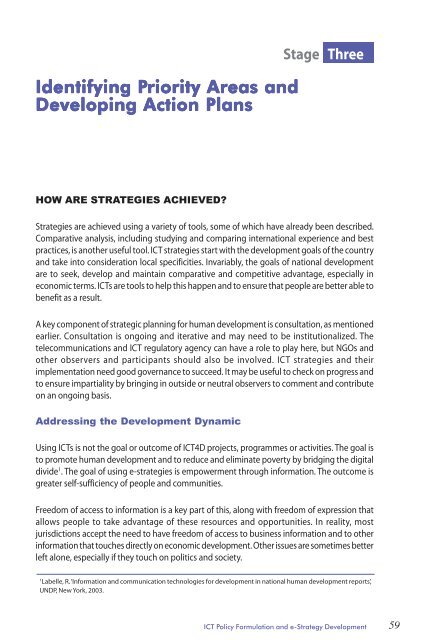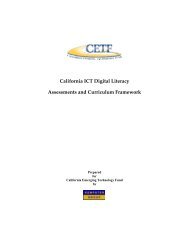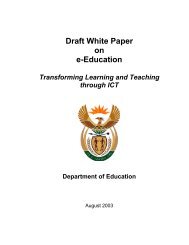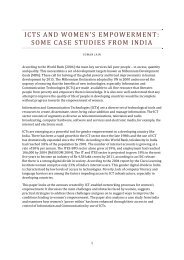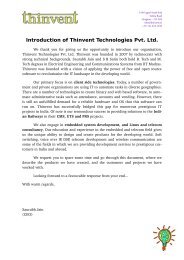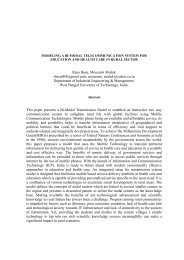ICT Policy Formulation and e-Strategy Development: A ... - un-apcict
ICT Policy Formulation and e-Strategy Development: A ... - un-apcict
ICT Policy Formulation and e-Strategy Development: A ... - un-apcict
Create successful ePaper yourself
Turn your PDF publications into a flip-book with our unique Google optimized e-Paper software.
Stage Three<br />
Identifying Priority Areas <strong>and</strong><br />
Developing Action Plans<br />
HOW ARE STRATEGIES ACHIEVED?<br />
Strategies are achieved using a variety of tools, some of which have already been described.<br />
Comparative analysis, including studying <strong>and</strong> comparing international experience <strong>and</strong> best<br />
practices, is another useful tool. <strong>ICT</strong> strategies start with the development goals of the co<strong>un</strong>try<br />
<strong>and</strong> take into consideration local specificities. Invariably, the goals of national development<br />
are to seek, develop <strong>and</strong> maintain comparative <strong>and</strong> competitive advantage, especially in<br />
economic terms. <strong>ICT</strong>s are tools to help this happen <strong>and</strong> to ensure that people are better able to<br />
benefit as a result.<br />
A key component of strategic planning for human development is consultation, as mentioned<br />
earlier. Consultation is ongoing <strong>and</strong> iterative <strong>and</strong> may need to be institutionalized. The<br />
telecomm<strong>un</strong>ications <strong>and</strong> <strong>ICT</strong> regulatory agency can have a role to play here, but NGOs <strong>and</strong><br />
other observers <strong>and</strong> participants should also be involved. <strong>ICT</strong> strategies <strong>and</strong> their<br />
implementation need good governance to succeed. It may be useful to check on progress <strong>and</strong><br />
to ensure impartiality by bringing in outside or neutral observers to comment <strong>and</strong> contribute<br />
on an ongoing basis.<br />
Addressing the <strong>Development</strong> Dynamic<br />
Using <strong>ICT</strong>s is not the goal or outcome of <strong>ICT</strong>4D projects, programmes or activities. The goal is<br />
to promote human development <strong>and</strong> to reduce <strong>and</strong> eliminate poverty by bridging the digital<br />
divide 1 . The goal of using e-strategies is empowerment through information. The outcome is<br />
greater self-sufficiency of people <strong>and</strong> comm<strong>un</strong>ities.<br />
Freedom of access to information is a key part of this, along with freedom of expression that<br />
allows people to take advantage of these resources <strong>and</strong> opport<strong>un</strong>ities. In reality, most<br />
jurisdictions accept the need to have freedom of access to business information <strong>and</strong> to other<br />
information that touches directly on economic development. Other issues are sometimes better<br />
left alone, especially if they touch on politics <strong>and</strong> society.<br />
1<br />
Labelle, R. ‘Information <strong>and</strong> comm<strong>un</strong>ication technologies for development in national human development reports’,<br />
UNDP, New York, 2003.<br />
<strong>ICT</strong> <strong>Policy</strong> <strong>Formulation</strong> <strong>and</strong> e-<strong>Strategy</strong> <strong>Development</strong><br />
59


